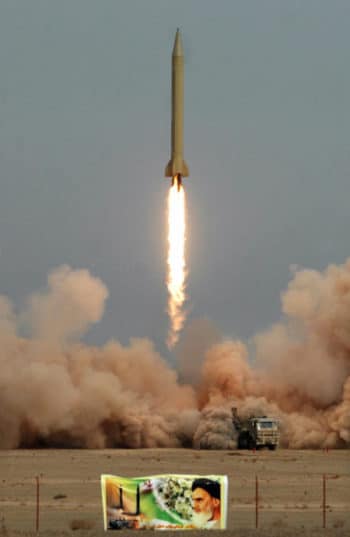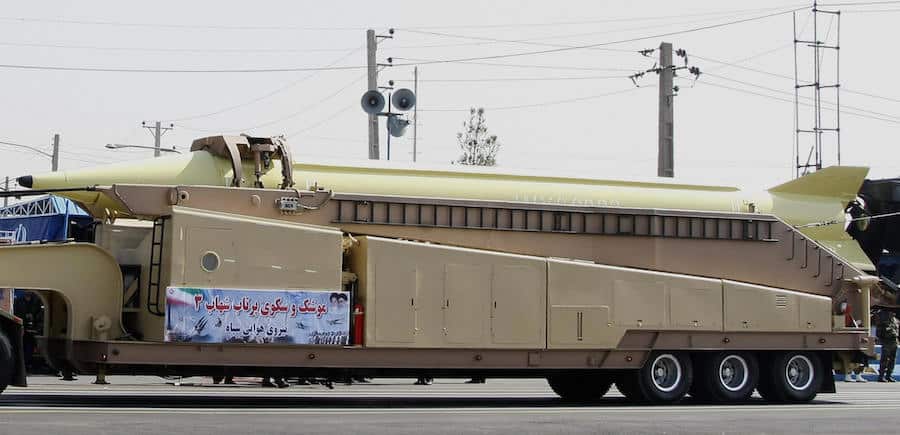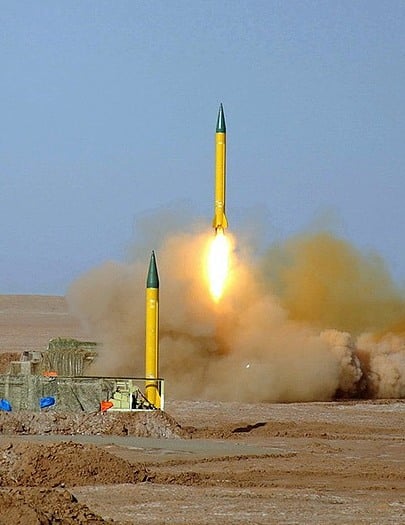The Shahab-3 is a medium-range, liquid-fueled, road-mobile ballistic missile. The Shahab-3 represents Iran’s first successful acquisition and development of a medium-range ballistic missile that give it the capability to threaten targets (such as Israel) which lie beyond its immediate borders. It has a range of about 1,300 km.
Shahab-3 at a Glance
- Originated from
- Iran
- Possessed by
- Iran
- Class
- Medium-Range Ballistic Missile (MRBM)
- Basing
- Road-mobile or silo-based
- Length
- 16.58 m
- Diameter
- 1.25 or 1.38 m
- Launch weight
- 17,410 kg
- Payload
- Single warhead, 760 – 1,200 kg
- Warhead
- Nuclear, HE, chemical, or submunitions
- Range
- 800 – 1,300 km
- Status
- Operational
- In service
- 2003 – present



Shahab-3 Development
After purchasing a North Korean No Dong 1 missile in the mid-1990s, Tehran established the infrastructure necessary to assemble a domestic version of the missile, named the Shahab-3.1 Iran likely began this development to acquire a long-range missile capable of striking targets in Israel and western Saudi Arabia.2
Iranian officials have disputed the missile’s North Korean origin, however, with former Defense Minister Ali Shamkhani asserting that “The Shahab-3 missile is entirely Iranian and has been designed by the domestic specialists.”3 Yet the No Dong and Shahab-3’s nearly identical appearance and capabilities – as well as the known missile and missile technology transfers between the two countries – make this claim highly unlikely. Pakistan has also employed No Dong technology to build its Hatf-5 “Ghauri” MRBM.
North Korea began developing the No Dong 1 in the mid-1980s. Neither North Korea, Iran, nor Pakistan had well-developed missile programs at the time, so it is presumed that the original technology came from either Russia or China. It seems likely that North Korea borrowed engine designs from the Russian SS-3 (R-5) missile, though the No Dong missile is significantly smaller. The connection to the Russian missile seems likely for two reasons: first, Russia has been known to declassify obsolete missile designs, thus allowing them to fall into other hands. Second, the No Dong is believed to use the same fuel and oxidizer as many Russian missiles.
North Korea began testing the No Dong in 1990. In 1993, it is believed that Iran and Pakistan entered into an agreement with North Korea to buy missiles and/or share the technology.4 At least one No Dong missile was tested in 1993, and Iran and Pakistan likely sent representatives to witness the test. While Iran initially planned to purchase and manufacture 150 No Dong missiles, international pressure forced North Korea to abandon the arrangement.5 In 1997, engine testing on the Shahab-3 began in Iran, presumably with a small number of No Dong missiles or missile components from North Korea.6 Iran likely declared the original Shahab-3 missile operational sometime in 2003.7
According to the International Atomic Energy Agency, Iran in the early 2000s may have explored various fuzing, arming and firing systems to make the Shahab-3 more capable of reliably delivering a nuclear warhead.8
Reports indicate that the Shahab-3 missile was designed by the state-run Iran Aviation Industries Organization (IAIO), with support from the Shahid Bagheri Industrial Group, Shahid Hermat Industrial Group, and Shahid Karimi Industrial Group.9
Specifications
Assessments of the Shahab 3’s capabilities are largely based upon speculation, as Iran is known to exaggerate its missiles’ performance, and declare untested technologies as operational. To further complicate capability assessments, Iran has continuously improved upon the Shahab-3 since its deployment in 2003, and it is frequently unclear which versions of the Shahab-3 are referred to by Iranian officials and western intelligence reports.
Contrasting reports suggest that the missile is between 15.6 and 16.58 m in length and 1.25 and 1.38 m in diameter. These same reports place the range between 800 and 1,300 km with payloads varying between 760 and 1,200 kg.10 The range is likely about 1,300 km, but varies widely depending upon the weight of the payload. Heavier and more effective payloads, like those employing first-generation nuclear warheads, would likely have a much shorter range than a smaller unitary high explosive warhead. Given the Shahab-3’s payload capacity, it would likely be capable of delivering nuclear warheads. The total launch weight is approximately 17,410 kg.
The Shahab-3 uses an engine that is similar to, but larger than that of the Scud missiles. The increased size allows for a significantly increased range without making the missile too large for Transporter-Erector-Launcher (TEL) basing. While using a single-stage liquid propellant engine, the Shahab 3 employs a separating reentry vehicle. Analysts note that Iran’s ability to build a single stage missile with a separating reentry vehicle is a significant intermediate step between its short-range, low payload missiles and longer-range, multi-stage missiles capable of carrying heavier payloads.
The Shahab-3 employs the basic inertial navigation system guidance used in the ‘Scud’ missiles, giving the missile an accuracy of about 2,500 m CEP. These original Shahab-3 missiles are primarily effective against large, soft targets (like cities). However, Iran has employed Chinese guidance technology on later variants to significantly improve strike accuracy.
Service History
Iran has conducted 21 Shahab-3 flight tests between July 1998 and August 2017. Following initial ground testing in 1997, the Shahab-3 was first flight tested in July 1998. The test appears to have been largely unsuccessful as the missile exploded prior to reaching any target (though it may have flown over 1,000 km). Iran conducted two successful Shahab-3 tests in in February and July 2000. A fourth test, supposedly of a satellite-launch variant, was unsuccessfully launched in September 2000. A fifth test in January 2002 failed after the missile caught fire during the pre-launch fueling sequence, though a sixth test in May 2002 was successful. A seventh flight test in July 2002 failed, followed by a successful test in September 2002.11 Iran conducted its ninth and “final” Shahab-3 test in July 2003, which successfully flew over 1,300 km.12
Since July 2003, the missile is believed to have been in operational use. Subsequent tests have primarily been held for Shahab-3 variants.
Initial production of 12 to 15 missiles per year may have begun as early as 1998. As of June 2017, Iran has deployed fewer than 50 Shahab-3 missile launchers; some estimates go as low as 25.13 As with most of Iran’s strategic missile systems, the Shahab-3 is operated by the Islamic Revolutionary Guards Corps (IRGC) and not by Iran’s conventional army (‘Artesh’).
Footnotes
- Iran’s Ballistic Missile Capabilities: A Net Assessment, an IISS Strategic Dossier, The International Institute for Strategic Studies, (East Sussex: Hastings Print, May 2010) 13.
- Ibid., 17-20.
- “Iran Says Shahab-3 Missile Entirely Iranian, Production Ongoing,” Space War, May 5, 2005, http://www.spacewar.com/news/iran-05o.html.
- Iran’s Ballistic Missile Capabilities: A Net Assessment, an IISS Strategic Dossier, The International Institute for Strategic Studies, (East Sussex: Hastings Print, May 2010) 18-19.
- “Shahab 3/4 (Ghadr-1),” in IHS Jane’s Weapons: Strategic 2015-2016, ed. Jane’s C O’Halloran (United Kingdom: IHS, 2016), 47.
- Ibid., 49.
- The International Institute for Strategic Studies, Open-Source Analysis of Iran’s Missile and UAV Capabilities and Proliferation (East Sussex: Hastings Print, April 2021), 11.
- International Atomic Energy Agency, “Final Assessment on Past and Present Outstanding Issues regarding Iran’s Nuclear Programs,” GOV/2015/68 (December 2, 2015): 13.
- Ibid., 50.
- Ibid., 48-49; Iran’s Ballistic Missile Capabilities, 17-24; Anthony H. Cordesman, “Iranian Weapons of Mass Destruction: Capabilities, Developments, and Strategic Uncertainties,” Center for Strategic & International Studies, 14 October 2008, available at http://csis.org/files/media/csis/pubs/081015_iran.wmd.pdf.
- CSIS Missile Threat, “Iranian Missile Launches: 1988-Present,” August 17, 2017, https://missilethreat.csis.org/iranian-missile-launches-1988-present/.
- Ilan Berman, Tehran Rising: Iran’s Challenge to the United States, (USA: Rowman & Littlefield, 2007), 60.
- “Ballistic and Cruise Missile Threat,” National Air and Space Intelligence Center (NASIC), June 2017, http://missilethreat.csis.org/wp-content/uploads/2017/06/06262017_nasic.pdf, 25.